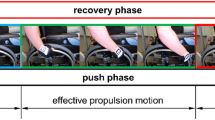Abstract
The purpose of this research was to obtain a single objective criterion that would constitute a reliable prediction of length and grade limits for ramps that can be traversed by any special category of wheelchair dependent individuals (WDI). The maximal voluntary force (MVC) is the main limiting factor of the performance of WDI, thus the force required to traverse a ramp has been established by means of a simple mechanical model. The real time course of force application during ascent was experimentally obtained. Then, a simplified law of force application was introduced in a computer simulation program of kinetics and kinematics of ascent. Inputs to the model were also the mass of the subject plus wheelchair, the initial velocity of the chair, and the ramp length. The output of the program was the force requirement for any given length/grade. When capsizing conditions were encountered the simulation ended. We tested the results thus obtained having some selected WDI successfully traversing ramps with the predicted length/grade specifications.
Similar content being viewed by others
Article PDF
References
Cerquiglini S, Figura F, Marchetti M, Ricci B 1981 Biomechanics of wheelchair propulsion. In: Morecki A, Fiolelus K, Keolzioz K, Wit A. Biomechanics VII-A 410–419.
Engel P, Hildebrandt G 1974 Wheel chair design technological and physiological aspects. Proceedings of the Royal Society of Medicine 19: 409–413.
Hildebrandt G, Voight E D, Bahn D, Berenders B, Kroger J 1970 Energy cost of propelling wheel chair at various speeds: cardiac response and effect on steering accuracy. Archives of Physical Medicine and Rehabilitation 51: 131–136.
ICTA 1974 Accessibility for disabled persons - norms in different countries. Compiled by the International Center on Technical Aids, Housing and Transportation, Stockholm, Sweden.
Lehman F J, Warren C G, Halar E, Stonebridge J B 1974 Wheel chair propulsion in the quadriplegic patient. Archives of Physical Medicine and Rehabilitation 55: 183–186.
McLaurin C A, Brubaker C E 1979 “Wheel chair biomechanics.” Disability, The MacMillan Press 471-477.
Sanderson D J, Sommer H J 1985 Kinematic features of wheelchair propulsion. Journal of Biomechanics 18: 423–429.
Sawka M N, Glaser R M, Laubach L L, Al-Samkari O, Suryaprasad A G 1981 Wheelchair exercise performance of the young, middle-aged, and elderly. Journal of Applied Physiology 50: 824–828.
Sawka M N, Glaser R M, Wilde S W, von Luhrte T C 1980 Metabolic and circulatory responses to wheelchair and arm crank exercise. Journal of Applied Physiology 49: 784–788.
Stoboy H B, Wilson-Rich W, Lee M 1971 Workload and energy expenditure during wheel chair propelling. Pareplegia 8: 223–230.
Van Der Woude L H V, Hendrich K M M, Veeger H E J et al. 1988 Manual wheelchair propulsion: effect of power output on physiology and technique. Medicine in science and sports 20: 70–78.
Van Der Woude L H V, De Groote G, Hollander A P, van Ingen Schenau G J, Rozendal R H 1986 Wheelchair ergonomics and physiological testing of prototypes. Ergonomics 29: 1561–1573.
Author information
Authors and Affiliations
Rights and permissions
About this article
Cite this article
Cappozzo, A., Felici, F., Figura, F. et al. Prediction of ramp traversability for wheelchair dependent individuals. Spinal Cord 29, 470–478 (1991). https://doi.org/10.1038/sc.1991.64
Issue Date:
DOI: https://doi.org/10.1038/sc.1991.64



